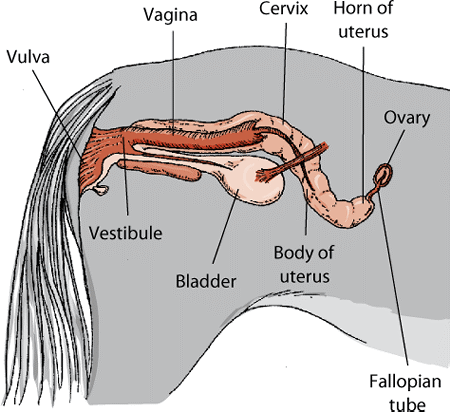The Gonads and Genital Tract of Horses
- Reproductive Disorders of Horses
- Introduction to Reproductive Disorders of Horses
- The Gonads and Genital Tract of Horses
- Infertility in Horses
- Congenital and Inherited Disorders of the Reproductive System in Horses
Both sexes have a pair of sexual organs or gonads (ovaries or testes), the main function of which is to produce eggs or sperm, respectively.
The Ovaries
Ovaries are female gonads that produce eggs and female sex hormones, including estrogen and progesterone. These hormones are necessary for the development of eggs and preparation of the uterus for pregnancy. Once puberty is reached and the horse starts its heat or estrous cycle, the size and form of the ovaries change. Within the ovary, a group of special cells form a follicle, which surrounds each egg. The estrous cycle begins when follicle stimulating hormone causes follicles to grow, leading to maturation of eggs and production of the hormone estrogen. Estrogen causes the brain to release luteinizing hormone, which stimulates the release of eggs from the ovary (a process called ovulation). After ovulation, the follicle becomes a corpus luteum, which produces progesterone. Progesterone causes the mare to go out of heat and prepares the uterus for pregnancy. If the mare does not become pregnant, the corpus luteum is destroyed and the mare returns to heat.
The Testes
Testes are male gonads that produce sperm and male sex hormones. Sperm maturation is stimulated by the production and release of follicle stimulating hormone and testosterone. Testosterone is required for proper function of the accessory sexual glands, male sex characteristics, and sexual behavior. For sperm production, the testes must descend into the scrotum (a pouch of skin outside the abdomen), because regular body temperature is too high for sperm to develop normally. The function of the testicles can be assessed by an evaluation of semen samples and hormonal tests. In addition, testicle examination and measurement may reveal reproductive diseases.
The Female Genital Tract
The female genital tract includes the vulva, vagina, cervix, uterus, oviducts, and ovaries. The oviducts are small tubes that connect the ovaries to the uterus. The end of the uterus is called the cervix. It separates the uterus from the vagina and provides a barrier against infection. The vagina (a muscular tube that extends from the cervix to the outside) is connected to the vulva (skin surrounding the opening of the vagina). The vulva is the external opening of the female genitals. After ovulation, eggs are transported to the uterus via the oviducts. Secretion of protein-rich fluid in the oviducts provides a proper environment for survival of the mature egg, fertilization, and the first few critical days of embryonic life. Proper functioning of the uterus and cervix are also required for the establishment and maintenance of pregnancy. Infections contracted at mating are common causes of female infertility because they interfere with the proper function of the uterus. Infertility in females can be diagnosed through various means, including physical examination, ultrasonography, hormonal tests, uterine culture, and biopsy of the uterine lining. The vagina and vulva serve as the copulatory organs and as the last part of the birth canal. Mares that have poor function of the vulva and vagina may be prone to recurrent contamination of the reproductive tract, leading to the development of chronic uterine infections and infertility.
The Male Genital Tract
In males, the genital tract provides a pathway for sperm cells and semen. The testicles produce sperm and testosterone (the main male hormone). Sperm pass from the testicles into the epididymis, where they mature and are stored. The epididymis is connected to the ductus deferens, which carries sperm to the urethra. The accessory sex glands, such as the prostate and seminal vesicles, create the fluid portion of semen. Abnormalities of the genital tract can be diagnosed by physical examination or ultrasonography. A semen evaluation can provide information regarding the quality and quantity of sperm and can give some estimate of fertility.
Resources In This Article
- Reproductive Disorders of Horses
- Introduction to Reproductive Disorders of Horses
- The Gonads and Genital Tract of Horses
- Infertility in Horses
- Congenital and Inherited Disorders of the Reproductive System in Horses







